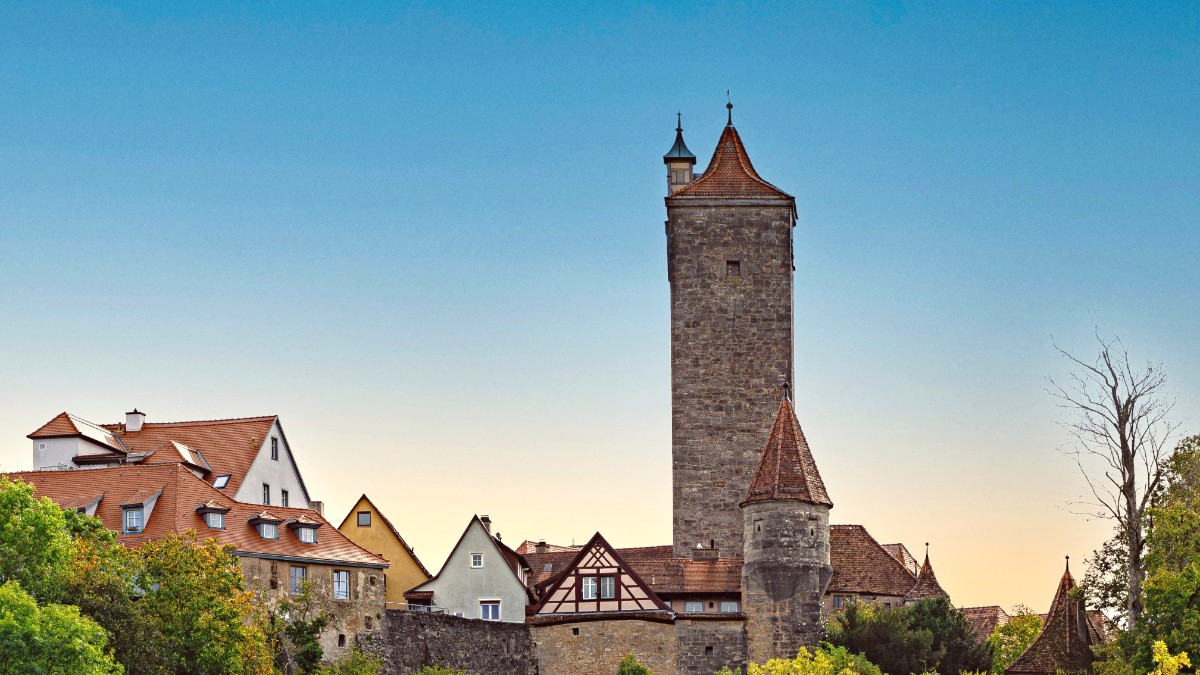
Bavaria, Germany
Sunlight illuminates the colorful facades, creating striking scenes. In the evenings, streetlights cast a warm glow, turning the town into a quiet, magical place. From the Town Hall tower, visitors view the red-tiled roofs stretching towards the Tauber Valley, a panorama that captures the essence of this historical gem. The town is compact for walking, encouraging slow travel and discovery around every corner. This immersive experience makes Rothenburg more than a destination; it offers a chance to connect with history in a truly personal way.
Rothenburg ob der Tauber sits in the heart of northern Bavaria, a region in southern Germany. It forms part of the administrative district of Ansbach in Middle Franconia. The town crowns a plateau that overlooks the winding Tauber River below, giving it its characteristic "ob der Tauber" (on the Tauber) designation. This strategic high ground gave the town natural defenses in earlier times.
The surrounding landscape of the Tauber Valley complements Rothenburg's historic core. Rolling hills, dense forests, and the gentle flow of the river create a scenic backdrop. The valley floor features meadows, vineyards, and small villages, inviting exploration. This contrast between the compact, walled town and the open, green valley has many options for walking, cycling, and enjoying the natural environment. Rothenburg also sits directly on the Romantic Road, Germany's well-known tourist route that connects picturesque towns and castles through Bavaria and Baden-Württemberg. Its location makes it an useful stop for those exploring this famous scenic drive.
Rothenburg ob der Tauber is a long and storied past, dating back to the Imperial period of the Holy Roman Empire. Its recorded history begins in 970 AD, with the construction of a castle. By the 13th century, it had become a Free Imperial City, a status that gave it autonomy directly under the emperor. This independence fueled its prosperity, helping it grow into a wealthy trading hub. Its location along important trade routes, notably for wine and cattle, contributed to its economic strength. The impressive Town Wall, numerous towers, and grand public buildings built during this period reflect its former wealth and influence.
The Thirty Years' War (1618-1648) marked a turning point for Rothenburg. Besieged by Catholic forces, the town faced destruction. According to legend, the town was saved when the mayor, Georg Nusch, accepted a challenge to drink a large tankard of wine, thereby saving the town from being burned. This event, known as the "Master Draught" (Meistertrunk), is celebrated annually. While the town survived, the war left it impoverished, and its prominence decreased. This decline inadvertently led to its remarkable preservation. With no funds for modernizing, Rothenburg remained largely untouched, keeping its medieval character intact. In the 19th century, romantic artists rediscovered the town, drawing attention to its unique beauty. Today, Rothenburg serves as a living museum, letting visitors walk through centuries of history, appreciating its resilience and enduring heritage.
First castle construction, early beginnings.
Achieves Free Imperial City status, fostering growth.
Thirty Years' War impact, "Master Draught" legend.
Rediscovered by romantic artists, tourism begins.
A living museum, welcoming visitors to its historic core.
Rothenburg ob der Tauber offers a distilled experience of Germany's medieval charm. Imagine entering a storybook setting where every street, every building, and every view is a piece of history. The town's enduring appeal comes from its authenticity and the care taken to preserve its unique ambiance. Visitors find themselves surrounded by well-preserved half-timbered houses, ancient town gates, and a walkable defensive wall that encircles the entire old town. This compact nature makes it simple to explore on foot, with new discoveries around every bend.
The atmosphere shifts throughout the day. Mornings bring quiet streets, perfect for photography and reflection. During the day, the town buzzes with activity as visitors explore its museums, shops, and restaurants. In the evenings, after most day-trippers depart, a calm settles over Rothenburg. The illuminated buildings create a warm, inviting glow, and the Night Watchman's Tour gives a captivating historical narrative under the stars.
The town also gains fame for its year-round Christmas shops and, of course, its popular Reiterlesmarkt during the Advent season. From its iconic Plönlein square to the panoramic views from the Town Hall tower and Castle Garden, Rothenburg brings countless moments for wonder. It brings a blend of historical depth, architectural beauty, and a welcoming atmosphere, making it a beloved destination for travelers worldwide.
Image Credit: The iconic Plönlein in Rothenburg ob der Tauber, a small triangular square with a half-timbered house and two diverging streets with towers. (Wikimedia Commons)
Rothenburg ob der Tauber's beauty is best appreciated through its distinctive landmarks and views. These images showcase the town's character and historical appeal.
From its elevated position overlooking the Tauber Valley to the intricate details of its medieval architecture, every corner of Rothenburg tells a visual story. These scenes capture the essence of the town, from bustling squares to quiet, picturesque lanes.
Ancient gates like Spitaltor and Rödertor mark entry points into the walled city, each with its unique historical presence.
A blend of Gothic and Renaissance styles, the Rathaus is a central monument, specifically its towering spire.
This peaceful garden, on the site of the former Hohenstaufen imperial castle, offers sweeping views of the Tauber Valley.
Rothenburg ob der Tauber, seen from the Tauber Valley, showcases the walled town on a plateau above the river. The commanding position of the town, high above the river, was a strategic advantage in medieval times.